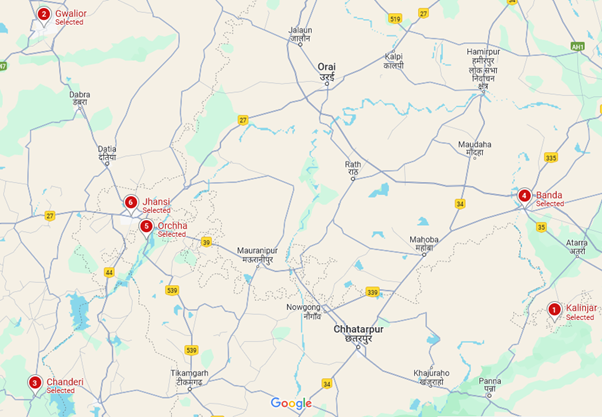After the murder of Jyotiba Shinde in Bundelkhand in 1743, the forces of Shinde and Holkar stayed in Malwa for the monsoon to control the province. Nanasaheb dealt with some issues on the west coast and took a couple of hill forts near Junnar belonging to the Nizam. The Nizam, therefore, sent his officer Sayyed Lashkar Khan to meet the Peshwa. This became a nagging issue between the two and Nanasaheb’s departure to the north was delayed until December 1744. By this time, Shinde and Holkar had subdued the Pathan Nawab of Bhopal, who then agreed to pay his annual tribute. They next laid siege to the fort of Bhilsa (Vidisha). In March 1745, the fort was captured and the treaty with the Nawab of Bhopal led to a cession of fifteen districts to the Peshwa besides a yearly payment of tribute. The ruler of Orchha was made to pay a tribute in money and elephants, and half of his territory was annexed. In his third campaign to the north in 1745, Nanasaheb stationed himself at Vidisha and began sorting out minor revolts in that area.
Ishwari Singh of Jaipur opened discussions with Shinde and Holkar, paid them the army expenses, and brought them to help him. In the month of February 1745, he defeated Madho Singh with this help. The Peshwa and his Sardars both kept up the policy of acquisition of money and did not pay attention to justice. Meanwhile, Ranoji Shinde died in the month of July 1745. After that, some estrangement occurred between his son Jayappa and his steward Ramchandrababa. Due to that the unanimity in the northern policy was disturbed.
In August 1746, Malharrao Holkar had written to the Peshwa about an evolving crisis in the Jaipur succession. He wrote that there was an agreement with the Rana of Udaipur by which Madho Singh was to receive a share of twenty-five lakh rupees, but Jaipur’s incumbent ruler Ishwari Singh was blocking it. Holkar advised the Peshwa that nobody from Delhi would join Ishwari Singh or object to any action against him, and that even nobles like Mansoor Ali Khan and Aamir Khan were in favour of Madho Singh. The letter reveals Holkar’s aim as early as 1746 to help Madho Singh gain the kingdom of Jaipur, which he claimed by virtue of being the son of an Udaipur princess.
Madho Singh and his uncle Jagat Singh did not quit the pursuit of their objectives. Meanwhile, Bundi’s Umed Singh Hada also lost his kingdom and he joined Madho Singh. On 4 October 1746, meeting at Nathdwara, they discussed many plans. They opened discussions with Malharrao Holkar and sought his help.
Along with the Jaipur dispute, the Maratha operations in the Gwalior region continued under Vitthal Shivdeo Vinchurkar. On 27 January 1747, he wrote to Shinde and Holkar that he had captured the fort of Antri, just south of Gwalior after a siege of a month and a half and was now working to capture the Narwar fort.
Malharrao sent his son Khanderao and attempted to broker some kind of compromise. But that could not get implemented, and the affair came to a head. Jaipur’s experienced and hereditary Dewan Khatri Aayamal, who has also been referred to in the documents with names Rajamal or Malji, died on 9 February 1747, and his son Keshavdas assumed the office of Jaipur’s Pradhan. Since then, the Maratha relationship with the Jaipur throne fell into disrepair.
The Rana of Udaipur sent his own envoy to meet the Peshwa to canvas for the cause of Madho Singh. The Peshwa was informed that Ishwari Singh had failed to hand over the promised territory to his brother. The Peshwa had taken Ishwari Singh’s side before this. Opposing that, Malharrao now took up Madho Singh’s side in hope of securing some money. The Peshwa fell into a dilemma.
Ishwari Singh was joined by Jayappa Shinde while Madho Singh was supported by Malharrao Holkar. The two Maratha Sardars were now in an open confrontation with each other. Ishwari Singh’s two commanders, Narayandas and Hargovind, attacked Madho Singh and the Rana on the battlefield of Rajmahal. The battle began on 1 March 1747, and went on for two days. “Ishwari Singh emerged victorious. He captured much plunder from Madho Singh’s contingent. Ranaji’s force ran away. Many people died on both sides. Khanderao Holkar was standing to a side. He was killed by Narayandasji.”
Ishwari Singh, supported by Shinde defeated Madho Singh with Holkar’s army and claimed the throne. After this, Jagat Singh sued for peace, which was accepted by Ishwari Singh, and he returned to Jaipur after the roaring success. A terrible famine was going on this year in the north. Due to this failure, Maharana became extremely dejected, and began pressing Malharrao for help.
To be continued…

